Communication Books & Aphasia
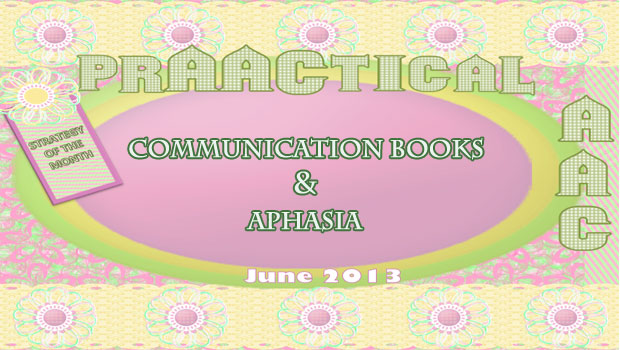
We know aphasia intervention has moved well beyond traditional speech and language training and intervention. We are so happy it has moved to an authentic participation, functional communication, and social interaction focus. Communication books are one tool for helping people with aphasia be active participants in conversation and comprehensive communication. Here are some thoughts and ideas about communication books to get started.
Communication Books- Communication books for adults with aphasia can be in grid format with relevant communication messages. There can be a few pages or many, but keep in mind that the more pages, the longer it will take to navigate. It is most important to include high priority and relevant messages that will support needed communication and not just ‘standard’ messages. There are many samples and templates that can be purchased or downloaded for adult communication books. These may be good as a start, but should be individualized when necessary or as soon as you can. Communication books can be text based or symbol based or a combination. The most important part of developing communication books is to involve the person with aphasia in the planning and organizing of the book. Then it will be most meaningful and relevant and thus more likely to be used.
Remnant Communication Books– Remnants are objects, papers, or materials that remind someone of an event or experience. Ticket stubs, maps, seeds, dried flowers, etc can all serve as remnants. These items provide a visual and tactile way of sharing information and connecting with others. Learners can help choose items from meaningful personal experiences which serve as a reminder of stories to tell. Remnant books can also be used to help with topic choice when selecting which story to ‘tell’. Multiple remnants about one experience allow for ‘extended’ conversation about one topic. Remnants can be arranged in a communication book in sheet protector pages, with hot glue onto pages, pockets, etc.
Low Tech Visual Scene Communication Books- Visual scene displays (VSDs) use photographs or images to portray events, people, actions, objects and activities with words and messages around the scene or if electronic with hot spots that bring up the words or messages. Visual Scene displays can be used for communication books. These scenes are used as an interface to language and communication. The idea for visual scenes is to make them extremely relevant and meaningful to the user. See AAC for Aphasia: A Review of Visual Scenes Display Project by David Beukelman, Karen, Hux, Kristy Weissling, Aimee Dietz, and Miechelle McKelvey for comprehensive information on visual display communication books.
4 Basic (but extremely important) Communication Book Considerations:
- Personalize the communication book for the user. It has to something a competent adult would want to take out and about town with them. Size, style, color, material, etc. matters. Everyone will have different ‘attractiveness’ priorities. It is worth the time and effort to include the person with aphasia in the decision making process. We all know that if we don’t like something, we won’t want to be seen with it.
- Make sure the messages, remnants, symbols are going to convey meaningful information. If the vocabulary or information in the communication book is not what the user wants to talk about, there will be no reason to use it. Also consider arrangement of vocabulary, symbols, remnants for ease of access, priority of topic, etc.
- Make navigation through the book easy physically, linguistically, and cognitively.
- Remember to decide (assess) what type of communicator will be using the communication book and develop strategies that go with that communication type.
An Additional Few Thoughts:
- All of these types of communication books can allow for partner supported communication by helping to provide visual support for for choice making, providing a symbol for stored message retrieval, topic initiation, and storytelling (Aphasia & AAC: Enhancing Communication Across Health Care Settings , or Garrett, K. L., & Lasker, J. P. (2007). AAC and severe aphasia: Enhancing communication across the continuum of recovery. Perspectives on Neurophysiology and Neurogenic Speech and Language Disorders, 17, 6–15.).
- All of these types of communication books need to be prAACticed in many meaningful communication situations.
- All of these types of communication books need to be modeled and the person with aphasia needs to see that communication is a two way street. When you model the use of the visual strategies, they get to understand better and see what is expected.
We would love to see any examples of communication books you use with people with aphasia.
Filed under: Strategy of the Month
Tagged With: AA, aphasia, COmmunication Books
This post was written by Robin Parker
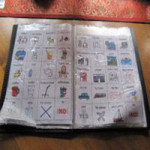
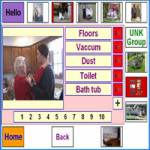

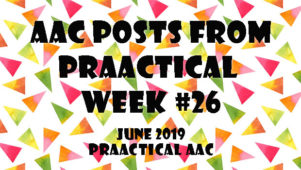
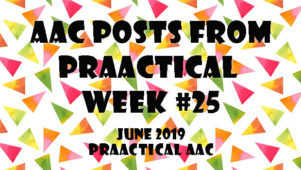
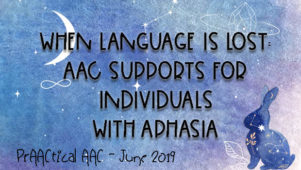

1 Comment
Nice Article. Thank you for sharing. This would be very helpful for those who has aphasia.